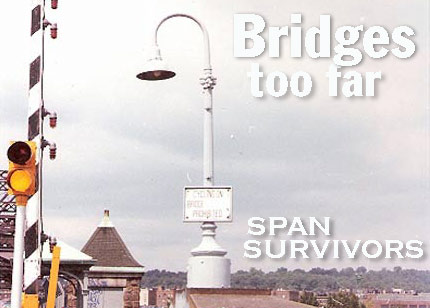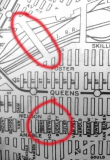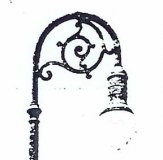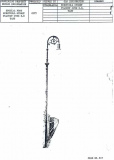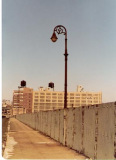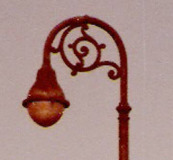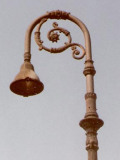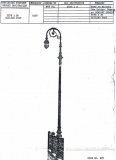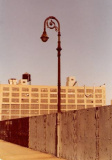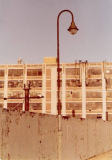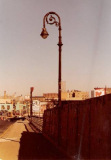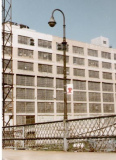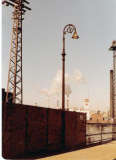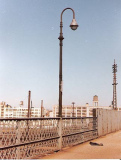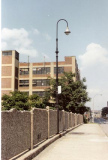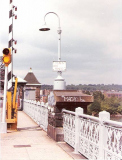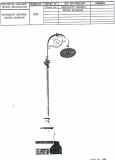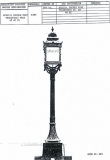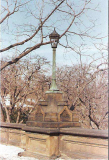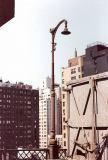Paralyzing inertia is my archenemy. Despite accumulating a wealth of knowledge about the relics and remnants of the NYC of the past throughout my teens, 20s and 30s, I didn’t begin to amass a library of photographs of these kinds of things until I was 40 years old, and while over the next few years I’ve been able to both photograph and collect thousands of pictures, think of how much I could’ve done if I’d bothered to get started earlier. After all I had a little Canon point and shoot camera sitting in my drawer since at least the early 1980s.
But I didn’t start shooting anything in earnest until early 1998 when I began researching Forgotten NY. I had only a handful…perhaps two dozen… pictures of the odd fixture or lamppost that was usable for the site. Why? The reason is unknowable. I had the camera, but didn’t use it. Part, though not all, of the reason is that I worked nights in the 1980s and slept between 7AM and 2PM. Had I known I’d be a NYC researcher, I would have roamed around after work, shooting things, but unfortunately no one can see the future. It was just paralyzing inertia, which plagues me to this day.
Fortunately, Sohoite Bob Mulero has been shooting NYC lampposts steadily since the mid-1970s, when many, many more priceless relics that we will never see again were still around. He has also acquired the holy book of NYC lamppost freaks, of which I am one of the five (Photographs of Street Lighting Equipment as of November 1, 1934 by an outfit called the System Electric Companies). This book vouchsafes the reader the precious knowledge that many genuses (genii?), species and subgenres of cast iron posts appeared in NYC between about 1900, when they first began to proliferate, but by 1940 mosy had been winnowed out to the Corvingtons, Bishop Crooks, Type Fs, etc. that Forgotten Fans who were around in the 40s or 50s remember. Before that, though, the poles that had proliferated took strange and wonderful forms indeed.
The late paleontologist Stephen Jay Gould wrote a book in 1989 called Wonderful Life that discussed the fossils dating back to the Cambrian Era, 550 million years ago, found in the Burgess quarry in British Columbia, Canada. Simply put, the fossils indicate that nature experimented with many fanciful forms and styles before settling on the species and phyla that have emerged since then. Even relatively recently nature has experimented with strange forms, the titanothere (a giant rhino); the litoptern (a thing that looked like a camel with a snout, with horse’s hooves) and giant anteaters and sloths. With the advent of man they disappeared.
In NYC, lampposts have evolved similarly. There were many strange-looking, seemingly impractical forms that emerged, only to meet quick extinction. In time, a handful of styles came to be adopted…until their mass extinction came around 1960.
Bob was able to capture some of these early experimental designs, and I’m very glad he did. A lot of future FNY pages will be based on Photographs of Street Lighting Equipment. On this page I’ll discuss some of the more recently deceased designs found on NYC bridges. Like the coelacanth or the recently discovered rat-squirrel, many species can exist, undetected, for eons. Who’s to say some of these poles still aren’t around somewhere? All pictures were taken by Bob between 1978 and 1984.
Honeywell
Sunnyside, settled in the 1700s by the Bragaw family, carried the names of prominent landowners on its street signs–which have been actually restored by the DOT in recent years. Honeywell Street, named for the builder of Thomson Avenue (now the western portion of Queens Blvd.) is now better known as 35th Street. It was bridged over Sunnyside Yards when they were built in 1910; the portion crossing the cut still carries “Honeywell Street” solely on its street signs. Many strange lighting fixtures could be found on its old 1910 span before it was replaced early in the 21st Century…
Subgenres
Photographs of Street Lighting Equipment lists the Special Post, Honeywell Street Viaduct, Code #317. To the layman this looks like a regular NYC Bishops Crook post. But there are style points which set this apart as quite different…
Compare the scrollwork of the Code 317 (left) to that of a regular Type 1 BC Bishop Crook (center). Note the the scrollwork is much, much simplified on the #317, as opposed to the usual “busier” ironwork found on standard-issue poles. The apex of the Type 1 BC contains a finial, which the #317 lacks.
Honeywell Street poles lacked the elaborate, heavy bases their street-bound counterparts had. Instead, their bases were built specifically to attach to the bridge fencing.
A second style, given in the Photographs of Street Lighting Equipment as code #227, was featured on a number of NYC bridges incluing Honeywell. It employed a more “conventional” Type 1 BC top that had more filigreed scrollwork.
You can see in the illustration how the pole originally interacted with metal fencing.
In the Honeywell pole at left, all decorative scrollwork and ornamentation has rusted or fallen away, leaving just a curved mast. The post at right had kept most of its original ironwork.
The #227 on Honeywell, left, gives a better indication of the original interaction with fencing. At right, a #317 stands in front of the smoke-belching Big Allis Con Ed plant. The Big Apple warehouse on Northern Blvd. is at right.
Other Sunnyside Yard traffic bridges had their own complement of antiquated poles which starkly contrasted the surrounding streetscapes, along with the bridges themselves.
LEFT: The Harold Avenue Bridge, now 39th Street, is along with Honeywell, incredibly trafficked since it is one of just a handful of crossings. There’s a lot of wear and tear and the somewhat delicate cast-iron structures got shaken up. Many of them lost their scrollwork. In the background is Standard Auto Parts, where your webmaster occasionally had worked part time.
RIGHT: Van Alst Avenue, now 21st Street, had its own set of combo fence-Bishop Crooks that had been replaced elsewhere (contrast the Deskey poles in the background). The concrete wall probably waas erected after the original metal fence was replaced.
It’s my guess, but the reason these living fossils remained in place for so long was that the railroads, not the DOT, owned them. Sunnyside Yards lays up LIRR, NJT and Amtrak trains (NJT’s only foray into the boroughs). In any case, the Honeywell Bridge was replaced in 2001-2, following the 39th St./Harold Avenue Bridge, which had been replaced in 1995.
Throughout the city, other strange creatures could be found at city bridges…
Code #334 was a post designed specifically for the University Heights Bridge spanning West 207th St in Inwood with Fordham Road in the Bronx. There were 4 such posts occupying the point where the approach roadway joins the bridge where they lit the sidewalks. In the illustration, note the close resemblance between the scrollwork and that of #317. There’s some grooves on the shaft that also remind me of the ones on old-fashioned subway lighting stanchions. In the picture, snagged by Bob Mulero in 1984, the scrollwork had already fallen off. There may still be a base remaining but the complete poles had vanished by 2006.
Code #385 was just one of dozens of styles of park bridge posts to be found around town. Check its original luminaire! By the time Bob found one in Central Park’s 65th Street Transverse Road in the 1980s a standard park luminaire, complete with vandal-prof iron cage, had appeared in its place.
Other bridges, too, have had weird forms that persisted until just a few years ago. A Type F complete with gumball luminaire (which must have made it topheavy) stood guard across from the 1890s Citizens Bank Building till the mid-1990s, and the Queensboro Bridge boasted modified Type Fs with radial wave diffusers till the early 1980s. These have all disappeared.
3/26/2006

